New Topics
Published Paper (page 2) (2016-2019)
"Dependence of the pickup-like ion effective heating on the poloidal
and toroidal magnetic fields during magnetic reconnection"
S. Usami, R. Horiuchi, H. Ohtani, Y. Ono, M. Inomoto, and H. Tanabe,
Physics of Plasmas Vol. 26, 102103 (2019)
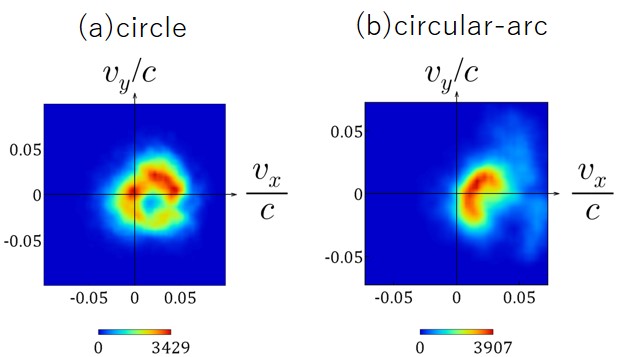
We have discovered that ions form circle/arc-shaped velocity distributions
(see the above figure) in the downstream of magnetic reconnection. The
dependence of the circle/arc-shaped velocity distributions on the magnetic
fields is investigated by means of particle simulations. The radius and
central angle of circle/arc depend on the poloidal and toroidal magnetic
fields, respectively. The tendencies account for results of plasma merging
experiments in STs. |
"Magnetic flux coordinates for analytic high-beta tokamak equilibria
with flow"
A. Ito and N. Nakajima,
Plasma Physics and Controlled Fusion Vol. 61, 105006 (2019)
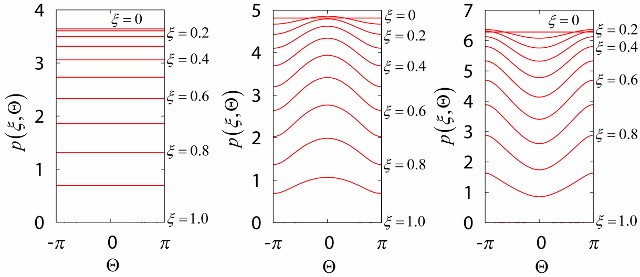
Poloidal profiles of the pressure on each flux surface for equilibria without
flow (left), with sub-sonic (center) and super-sonic (right) poloidal flows.
The pressure profiles in the poloidal direction on each flux surface become
non-constant due to flow. The transition occurs between sub- and super-sonic
poloidal flows. |
"Three-dimensional effect of particle motion on plasma filament dynamics"
H. Hasegawa and S. Ishiguro,
Physics of Plasmas Vol. 26, 062104 (2019)
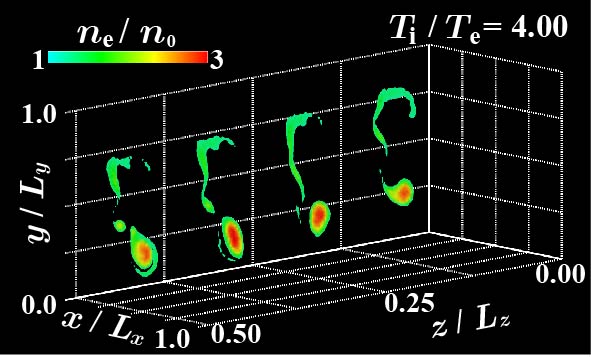
It is shown for the first time with the three-dimensional electrostatic
particle-in-cell simulation that the plasma particle motion influences
plasma filament dynamics three-dimensionally. In the high Ti case, the
pre-sheath potential drop on the potential hill in the filament cross-section
becomes larger than that on the potential well. The large pre-sheath drop
on the hill side induces the strong dependence of the perpendicular electric
field in the filament on the toroidal position. The filament dynamics in
the high Ti case, in which the poloidal symmetry breaking occurs, are significantly
influenced by such a 3D structure of the electric field as shown in the
above figure. |
"Impurity Ion Transport by Filamentary Plasma Structures"
H. Hasegawa and S. Ishiguro,
Nuclear Materials and Energy Vol. 19, 473 (2019)

This study has investigated the dependence of the impurity ion transport
by a plasma filament on various parameters with the three-dimensional (3D)
Particle-in-Cell (PIC) simulation; (1) The effective diffusivity of impurity
ions has a positive correlation
with the filament poloidal size (Fig. (a)). (2) The effective diffusivity
of impurity ions has a slight inverse correlation with the ion temperature
(Fig. (b)). (3) The effective diffusivity of impurity ions becomes quite
small in the heavy impurity ion mass case (Fig. (c)). |
"Improvement of the Multi-Hierarchy Simulation Model Based on the
Real-Space Decomposition Method"
S. Usami, R. Horiuchi, H. Ohtani, and M. Den,
Plasma Vol. 1, 90 (2018)
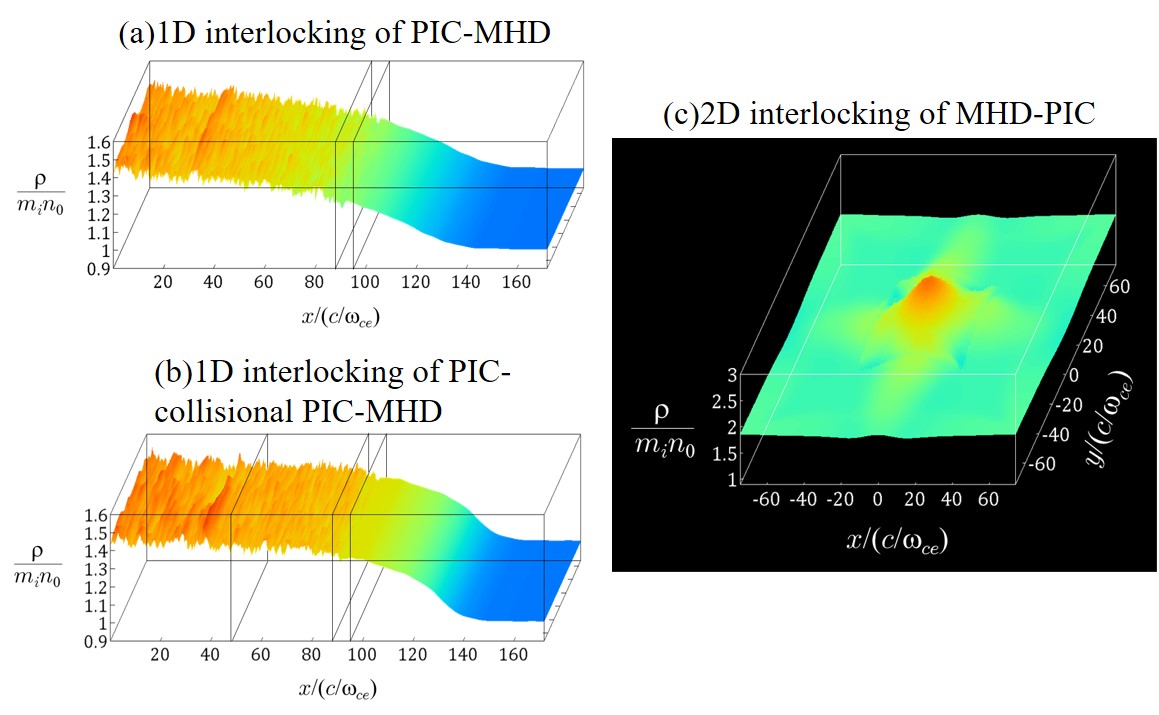
The multi-hierarchy model by the authors is improved to three types of
new models, i.e., two types of the 1D interlocking with the downstream
condition (Figs.(a)(b)) and one type of the 2D interlocking with the upstream
condition (Fig.(c)). For their verification, simulations of plasma propagation
across the multiple domains were performed and it was confirmed that the
new interlocking methods are physically correct. |
"Microscopic Effect on Filamentary Coherent Structure Dynamics in
Boundary Layer Plasmas"
H. Hasegawa and S. Ishiguro,
Plasma Vol. 1, 6 (2018)
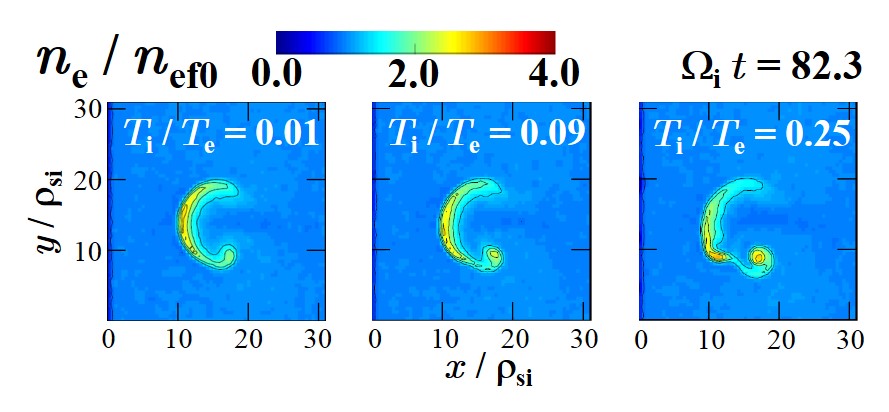
This study has demonstrated kinetic behaviors on the plasma filament propagation with the three-dimensional (3D) Particle-in-Cell (PIC) simulation. When the ion-to-electron temperature ratio Ti / Te is higher, the poloidal symmetry breaking in the filament propagation occurs due to the unbalanced potential structure which arises from the effect of the gyro motion of plasma particles. The poloidal symmetry breaking disturbs the radial propagation of a filament. The ratio between the observed and theoretical radial propagation velocities has a linear relation with the square of the difference between the ion and electron gyro radii. |
"Numerical analysis of two-fluid tearing mode instability in a finite
aspect ratio cylinder"
A. Ito and J. J. Ramos,
Physics of Plasmas Vol. 25, 012117 (2018)
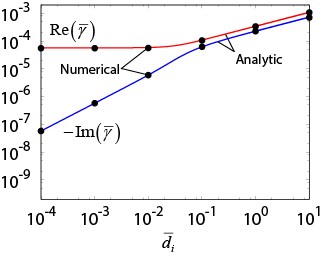
The two-fluid resistive tearing mode instability in a periodic plasma cylinder
of finite aspect ratio is investigated numerically. The real and imaginary
parts of the mode growth rate and the eigenfunctions are comparable for
parameters such that the cylindrical aspect ratio and two-fluid effects
are of order unity. |
"Effect of polycrystalline structure on helium plasma irradiation
to tungsten materials"
S. Saito, H. Nakamura, S. Yooyen, N. Ashikawa, and K. Katayama,
Japanese Journal of Applied Physics Vol. 57, 01AB06 (2017)
Binary-collision-approximation-based (BCA-based) simulation is performed
for the investigation of the effect of polycrystalline structure on the
penetration depth, the absorption rate, and the sputtering yield of tungsten
materials irradiated by helium plasma. To clarify the possibility of suppressing
the generation of helium bubbles in tungsten materials by designing the
polycrystalline structure such as grain size, the effect of polycrystalline
structure on the helium bubble formation is also investigated.
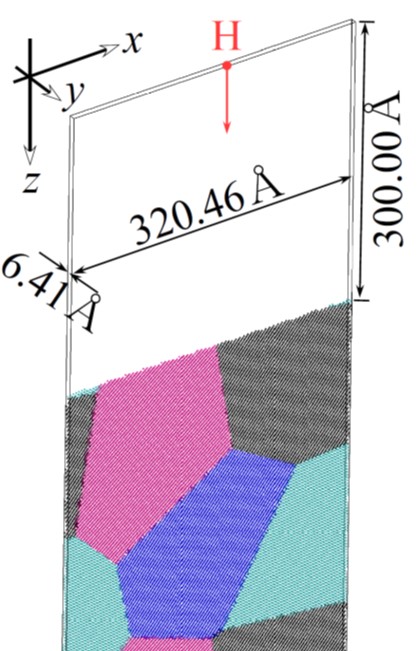
Fig: Simulation model of helium injection into polycrystalline tungsten
with the xyz coordinates of our simulation. |
"Applications of virtual-reality technology to fusion science and
engineering"
H.Ohtani and S.Ishiguro,
Proceedings of 36th JSST Annual International Conference on Simulation
Technology, 194 (2017)
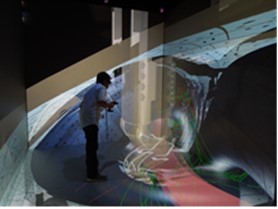
We have developed a system in which the plasma simulation results are shown
together with the experimental observation data in the reactor design data.
This system promotes the viewer’s under-standing..

We can seek the efficient assembly and replacement procedures by investigating
the component movements including the robot motion in the VR space previously.
The VR technology is expected to play an important role in the fusion reactor
operation, such as design, construction, and maintenance. |
"Development and Verification of the Three-Dimensional Electrostatic
Particle Simulation Code for the Study of Blob and Hole Propagation Dynamics"
H. Hasegawa and S. Ishiguro,
Plasma and Fusion Research Vol. 12, 1401044 (2017)
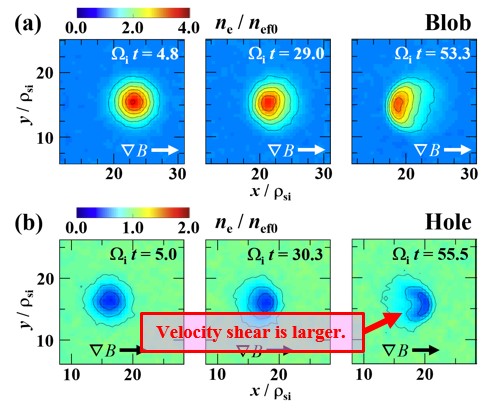
The three-dimensional (3D) electrostatic particle-in-cell (PIC) simulation
code for the study of blob and hole propagation dynamics has been developed
and verified; (1) the observed relations between the propagation speed
and the structure size in the blob and hole simulations are in good agreement
with the theoretical relations, (2) the code has reproduced a larger distortion
of a hole shape than that of a blob shape as shown in the figure, and (3)
the code has shown that the propagation of a blob or a hole is faster without
end plates (Such a situation is similar to the detached state). |
"Impurity transport caused by
blob and hole propagations"
H. Hasegawa and S. Ishiguro,
Nuclear Fusion Vol. 57, 116008 (2017)
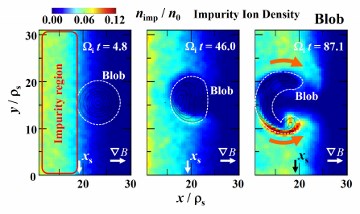
In this study, the dynamics between impurity ions and the blob and hole
structures have been investigated with the three-dimensional electrostatic
particle-in-cell simulation. The simulations have shown the following facts:
(1) The dipolar profile of impurity ion density in the blob / the hole
is formed. (2) Such a density profile propagates with the blob/ the hole.
(3) The effective radial diffusion coefficient for impurity ions by a single
blob / hole is comparable to the Bohm diffusion coefficient (the figure
shows impurity ion tranport by a blob). |
"Numerical simulations of interchange/tearing instabilities in 2D
slab with a numerical model for edge plasma"
H. Miura, L. Zheng, and W. Horton,
Physics of Plasmas Vol. 24, 092111 (2017)
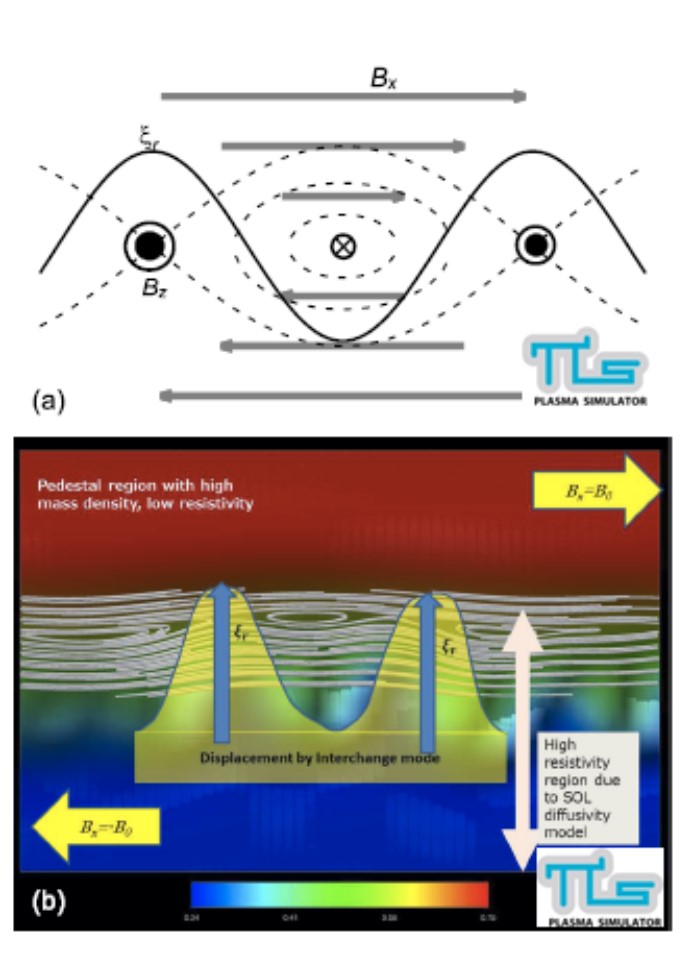
Fig: (a) A schematic view of the current interchange-tearing mode drawn
with the magnetic field lines. (b) The contours of mass density in a small
computational domain, drawn with a schematic line of the displacement xr.
(Copied from Fig.5 of the article.) |
"Effective heating of nonadiabatic protons in magnetic reconnection
with a guide field"
S. Usami, R. Horiuchi, and H. Ohtani,
Physics of Plasmas Vol. 24, 092101 (2017)
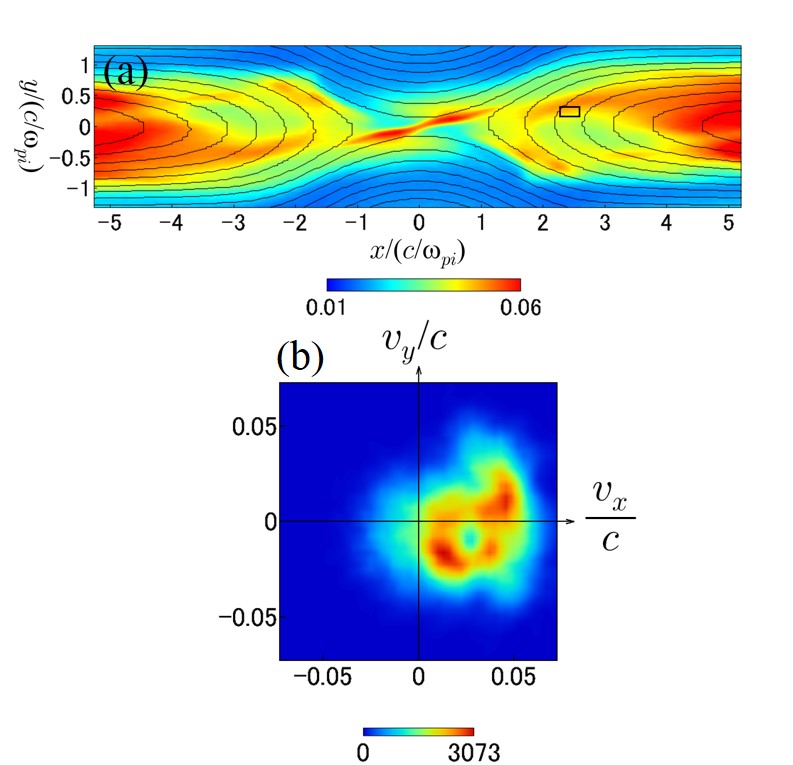
Mechanism of ion heating through magnetic reconnection with a guide magnetic
field is investigated by means of electromagnetic particle simulations.
Figure (a) shows the spatial profile of the ion temperature and Fig. (b)
displays the ion velocity distribution at the boxed area. It is observed
that the iontemperature is increased in the downstream, where a ring-like
structures of the ion velocity distributions is formed. Therefore, we can
see that ions are effectively heated. |
"Two-fluid tearing mode instability in cylindrical geometry"
A. Ito and J. J. Ramos,
Physics of Plasmas Vol. 24, 072102 (2017)
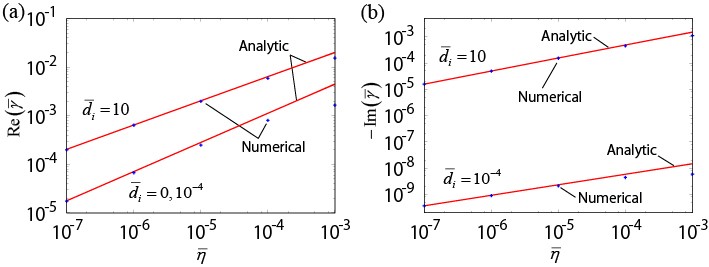
The cylindrical dispersion relation for the resistive two-fluid tearing instability shows the dependence of the mode growth rate and real frequency on the ion skin depth, through different regimes that range from the single-fluid MHD limit to the electron MHD limit. The numerically obtained eigenvalues agree very well with the analytic dispersion relation and the agreement improves the smaller the resistivity and the larger the ion skin depth are. |
"Two-fluid sub-grid-scale viscosity in nonlinear simulation of ballooning
modes in a heliotron device"
H. Miura, F. Hamba, and A. Ito
Nuclear Fusion Vol. 57, 076034 (2017)
A large eddy simulation (LES) approach is introduced to enable the study
of the nonlinear growth of ballooning modes in LHD. A model to substitute
the influence of scales smaller than the grid size, at sub-grid scale (SGS),
and at the scales larger than it - grid scale (GS) - has been developed
for LES. The LESs of two-fluid MHD equations with SGS models have successfully
reproduced the growth of the ballooning modes in the GS and nonlinear saturation.
The introduction of the LES approach has reduced the computational cost
drastically.
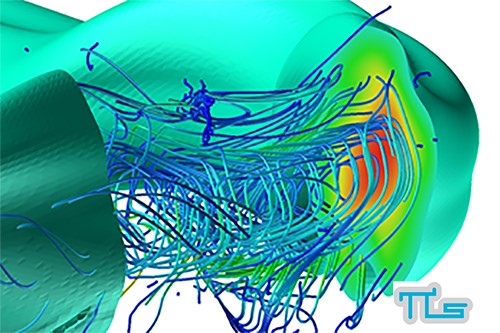
Fig: Pressure isosurface, contours and streamlines in a two-fluid LES of
ballooning modes in LHD, for b0 = 3.6% and Rax = 3.6 m unstable equilibrium. |
"Parameter dependence of two-fluid and finite Larmor radius effects
on the Rayleigh-Taylor instability in finite beta plasmas"
A. Ito and H. Miura,
Physics of Plasmas Vol. 23, 122123 (2016)
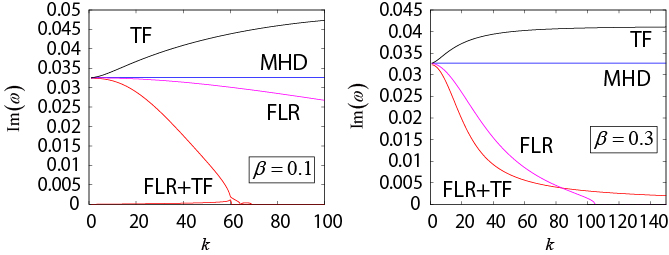
Growth rates of the Rayleigh-Taylor instability as functions of the wavenumber
for different MHD models. For the two-fluid MHD model with the FLR term,
it is shown that the absence of complete stabilization occurs for the beta
different from that for the MHD model with the FLR term, the mode is not
always most stable among those for the other models, depending on beta. |
|
|
 NIFS WEB
NIFS WEB NIFS WEB
NIFS WEB